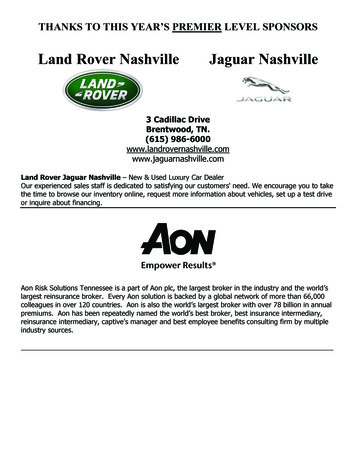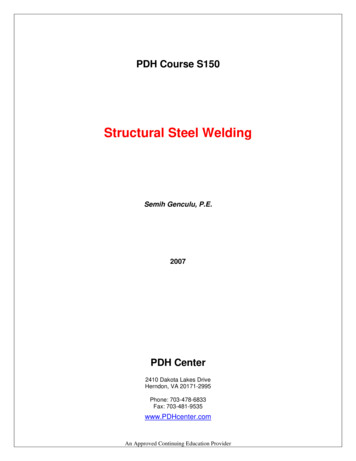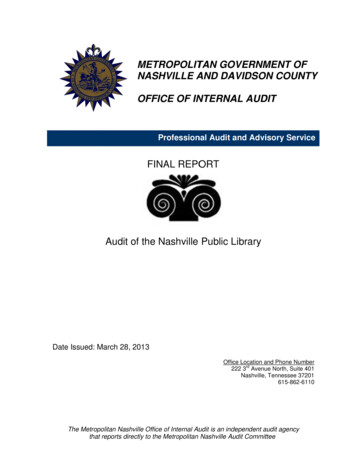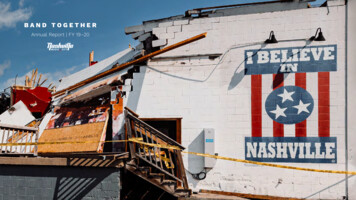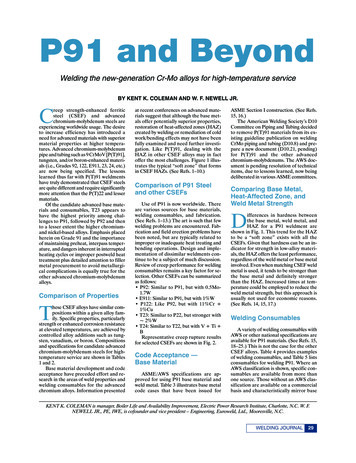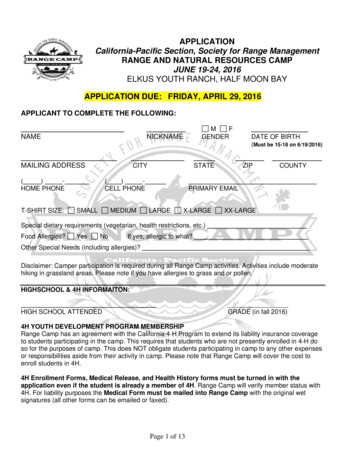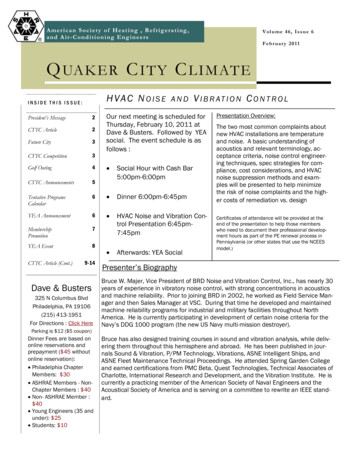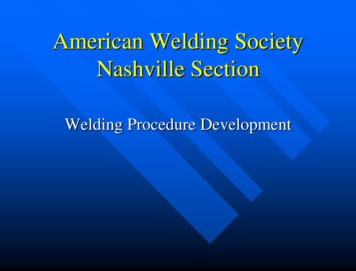
Transcription
American Welding SocietyNashville SectionWelding Procedure Development
AWS & ASMEWelding Procedures
Welding ProcedureSpecification (WPS) Written document that provides direction tothe welder for making production welds inaccordance with Code requirementsRules for qualification of procedures vary byreferencing Code– Qualified by testing (ASME, AWS)– Pre-qualified (AWS)– Standard Welding Procedure Specification(AWS)
AWS Standard Welding ProcedureSpecification (SWPS)Procedures that have been qualified bythe Welding Research Council acceptedand published by AWS for use as aqualified welding procedure ASME and NBIC accepted proceduresare listed in the appendix of theapplicable Code
Welding ProcedureQualification (PQR) A test that is performed to demonstrate thatthe contractor can make satisfactory welds asspecified in the Welding ProcedureSpecificationMechanical testing is required and NDE maybe required, depending on the Code beingqualified toImpact testing may be required by thereferencing Code (i.e., ASME Sect VIII)
Welder PerformanceQualification Test (WPQT) Performance test which determines the weldersability to make acceptable production welds under agiven set of conditions (essential variables)–––––––ProcessJoint typeBase metalFiller metalPositionGasElectrical characteristics
Which Comes FirstWPQTWPSPQR
Which Comes FirstTo frame a house you need to know thesize of the foundation To build a foundation you need to knowthe size and shape of the house
Which Comes First The roof does not have to cover thehouse but should be fully supported bythe framing
The Welding House The WPS and the PQR are developedconcurrently– Rough draft the WPS to determine how to do thePQR(s)– More than one PQR may be required to fullysupport the WPS (e.g., thickness range)– Welder qualification tests should be designed tonot exceed the limits of the WPS but do not needto meet all of the limits of the WPS
AWS B2.1 Specification for Welding Procedure andPerformance Qualification– Base metals categorized in M number formatSimilar to ASME P numbers– Similar to ASME Section IX
ASME B&PV Code ASME B&PV Code Section IX containsthe guidelines for welding procedure andwelder qualification– Requires procedure qualification for allwelding procedures except when thecontractor has adopted one of the AWSStandard Welding Procedure Specifications
AWS Codes Many AWS Codes allow the use of Prequalified Welding Procedures– Pre-qualified procedures are written documentsthat define welding parameters for the welder andare within defined limits set by the referencingCode (e.g., AWS D1.1)– Welding procedures that exceed the limits forpre-qualification must be qualified by testing
Develop the WPS Process(es)Material(s)Material thicknessJoint designFiller metalWeld depositthickness PositionsPre-heatPost heatShielding gasElectricalcharacteristicsTechnique
Qualify or Not to QualifyDoes the Code allow use of a prequalified procedure? Does the planned WPS stay within thelimits of a pre-qualified procedure? – Process, joint type, material, filler metal,position, deposit thickness
What is in the WPS The WPS should describe all essential,non-essential and when required by thereferencing Code supplementaryessential variables for each weldingprocess
Essential VariablesEssential variables are those variables inwhich a change, as described in thespecific variables, is considered to affectthe mechanical properties of theweldment If there is a change in the essentialvariable the procedure must be requalified
Supplementary EssentialVariables Supplementary essential variables are required formetals for which other Sections or Codes specifynotch-toughness testing and are in addition toessential variables for each process– This means that when ASME Section VIII (which requiresqualification to Section IX) also requires notch toughnesstesting on a material, the supplementary essential variablesbecome essential variables for that WPS– A change in either essential or supplementary essentialvariables requires re-qualification of the procedure
Nonessential Variables Nonessential variables are those inwhich a change, as described in thespecific variables, may be made in theWPS without re-qualification
Qualifying a procedure Determine what the required essential and ifapplicable supplementary essential variables are for:–––––––––ProcessJointsBase metalsFiller metalsPositionsPre & post weld heat treatmentGasElectrical CharacteristicsTechnique
SMAW Variables (ASME Sect IX)
Welding Data(ASME Sect IX) The welding variables table refers to theparagraph in the welding data section ofthe Code– These paragraphs give rules for specificapplications (specific variables)
Welding Data(ASME Sect IX)
Planning the PQR Plan your PQR to give you the greatestpossibility of success!– Base metal and filler metal grouping– Thickness limitations– Multiple processes require addressingessential variables for both processes– Note that position is not an essential variableunless notch toughness testing has beenrequired, take advantage of that
Base Metal Assigned P numbers (M or S) so that similarbase metals may be qualified by testing onebase metal in the same P number (essentialvariable)Group numbers may be assigned within a Pnumber to further differentiate(supplementary essential variable)– SA-106 Grade B P-No.1, Group-No.1» 60 KSI min specified tensile– SA-106 Grade C P-No.1, Group-No.2» 70 KSI min specified tensile
Filler Metals F number– Electrodes and weld rods are grouped to reducethe number of welding procedure andperformance qualifications where it can belogically done A number– Classification of ferrous weld metal analysis Product Form– Flux cored– Bare (solid) or metal cored– powder
Preheat Decrease 100 F– Essential variable Increase 100 F– Supplementary essential variable
Post Weld Heat Treatment PWHT– Essential variable PWHT (Time & Temp range)– Supplementary essential variable Base metal thickness (T) limits– Essential variable
QW-407.1 A separate PQR is required foreach of the following conditions. For P-Nos. 1,3,4,5,6,9,10 & 11– No PWHT– PWHT below the lower transformation temp– PWHT above the upper transformation temp» normalizing– PWHT above the upper transformation temp followed byHT below the lower transformation temp» Normalizing or quenching followed by tempering– PWHT between the upper and lower transformation temp
QW-407.1 cont’d For all other materials– No PWHT– PWHT within a specified temperature range
Test Plate or Pipe Joint 1G position whenpossible (Flat)Plan sequence of weldpasses if multi passBack grind and PT if twosided weldGrind stops and starts
PQR Test CouponsReducedTensileRoot orSide BendRoot orSide BendDiscardDiscardFace orSide BendFace orSide BendReducedtensile
Two Birds With 1 Stone The Procedure Qualification and WelderQualification can be done at the same time– Plate 1G– Pipe 6G Tests required for Procedure Qualification– Bend– Tensile– Notch Toughness if required by referencing Code
Read The Notes!
Required Testing for PQR(ASME Sect IX)
Pre-qualified WPS May be written to perform a specific weld within alimited range of variables––––– One joint design (i.e., V-Groove with backing)Material thickness limited or un-limitedProcess (i.e., SMAW)Position may be limited or all positionCurrent and voltage range limitedMay be written to perform multiple welds, takingadvantage of a broad range of materials, joint types,positions, etc.
AWS D1.1 Pre-qualified WPS
AWS D1.1 Pre-qualified WPS
AWS D1.1 Pre-qualifiedjoint designNotes
Notes
Pre-qualified Base Metals
Pre-qualified pre-heat table
Notes for base metalsand pre-heatingNotpre-qualified
Welder QualificationEssential Variables Joints– With or without backing Base metal– Pipe diameter– P number
Welder QualificationEssential Variables Filler metal––––––With or withoutF numberInsertsSolid or metal cored“t” of deposit“t” limits of short circuiting transfer
Welder QualificationEssential Variables Position–––– FlatHorizontalVerticalOverheadProgression – vertical welding– Up– Down
Welder QualificationEssential Variables Gas– Deletion of inert backing gas Electrical characteristics– GMAW – transfer mode– GTAW – current or polarity
Welder Qualification Main controlling factors– Process– Filler metal– P number qualified» It is your responsibility to ensure that the fillermetal and base metal are suitable for theapplication
Welder QualificationBase MetalTest on pipe or plate? Any P-No. 1 through 11, P-No. 34, or PNo. 41 through 47 qualifies for any PNo. 1 through 11, P-No. 34, or P-No. 41through 47 base metal P-No. 21 through P-No. 25 (same) P-No. 51 through P-No. 53 or P-No. 61through P-No. 62 (same)
Welder QualificationF-Numbers Some cross qualification exists with Fnumbers for example– Any F6 qualifies for F6– Any F21 – F25 qualifies for F21 – F25– Any F34 or F41 – F47 qualifies for F34 &F41 - F47
Welder QualificationF-Numbers SMAW electrode F numbers 1 – 4 areinter-related (ASME) and with orwithout backing applies– F4 without backing qualifies for F1, F2, F3& F4 with backing and F4 without– F4 with backing qualifies for F1, F2, F3 &F4 with backing only
Welder QualificationWeld Deposit “t” ASME– Up to and including 3/8” thick qualifies 2t– Over 3/8” qualifies 2t– 1/2” & over with minimum of 3 layers of weldmetal qualifies for the maximum to be welded AWS D1.1– 1/8” t 3/8” qualifies for 2t– 3/8” t 1” qualifies for 2t– 1” and over qualifies for unlimited
Welder QualificationPosition (ASME) 1G plate qualifies– F plate & pipe 2 7/8” OD & over groovewelds and F fillets 2G plate qualifies– F & H plate & pipe 2 7/8” OD & overgroove welds and F & H fillets
Welder QualificationPosition (ASME) 3G plate qualifies– F & V plate & pipe groove welds 24” OD &over and F, H, V fillets– F pipe 2 7/8” OD & over groove welds 4G plate qualifies– F & O plate & pipe groove welds 24” OD &over and F, H, O fillets– F pipe 2 7/8” OD & over groove welds
Welder QualificationPosition (ASME) 1G pipe– F groove & fillet 2G pipe– F & H groove & fillet 5G pipe– F, V & O groove & fillet 2G & 5G pipe or 6G pipe– All groove & fillet
Welder Qualification(ASME) Diameter limits based on OD of test couponfor groove welds– 1” OD size welded to unlimited– 1 2 7/8” OD 1” OD to unlimited– 2 7/8” OD & over 2 7/8” OD to unlimited Groove weld test qualifies fillets for all basematerial thickness, sizes and diameters
Welder Qualification Most testing can be done on carbon steeltest coupons to save money– e.g., welder qualifications can be completedfor most nickel alloys by using a filler fromthe F-41 through F-47 group welding acarbon steel test coupon 6G pipe position is the most economicaltest position
Qualification by WorkmanshipTest Only permitted when allowed by thereferencing documentRequires completion of a workmanship testaddressing typical production joints andconditionsPrimarily accepted on the basis of visualinspectionOther tests or examinations may be requiredby the referencing document (e.g., macroexamination)
Continued Qualification ASME, AWS (except D9.1) requires that thewelder must satisfactorily weld using theprocess at least once each six months toremain qualified– D9.1 is 12 months Re-qualification may be done on pipe or platein any position, material thickness ordiameter to regain qualification for allpositions, thickness, materials and diameterspreviously qualified for with that process
ASME, AWS (except D9.1) requires that the welder must satisfactorily weld using the process at least once each six months to remain qualified – D9.1 is 12 months Re-qualification may be done on pipe or plate in any position, material thickness or diameter to regain qualification for all positions, thickness, materials and diameters
